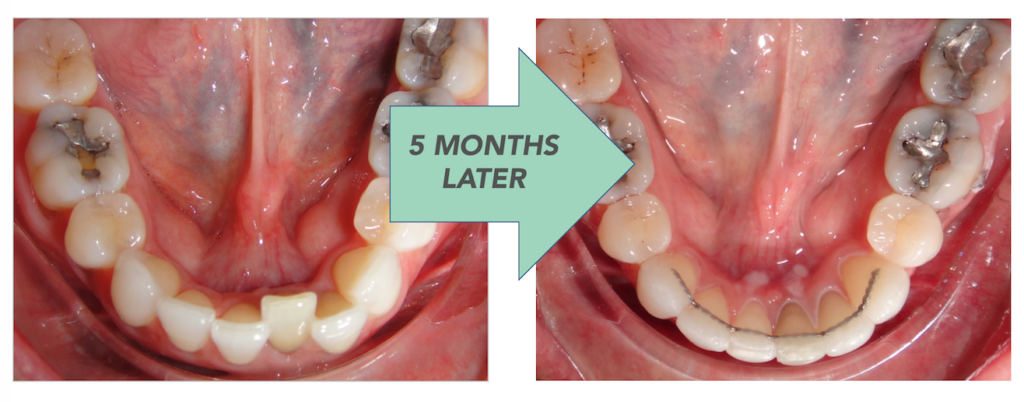Many people are surprised to learn that the teeth continue to move throughout life. This always leads to many questions about retainers and keeping the teeth straight. Let's dive into a few common questions.
Why do we need retainers?
Retainers help keep the teeth straight after they have been aligned with braces or Invisalign. Our teeth are held into the bone by ligaments, and over time as we age, our bones and ligaments change. As these changes occur, our teeth will unfortunately move. Example of teeth that shifted due to lack of retainer wear. We corrected the teeth with Invisalign, and placed a "fixed" retainer glued to the back of the teeth to prevent future shifting.
Example of teeth that shifted due to lack of retainer wear. We corrected the teeth with Invisalign, and placed a "fixed" retainer glued to the back of the teeth to prevent future shifting.
What types of retainers are there?
Retainers come in many shapes and forms. In our office, we use three main types of retainers. We use "fixed" retainers (AKA glued retainers, bonded retainers, permanent retainers) in many cases to hold the lower teeth straight. We use these retainers often because the lower front teeth tend be the teeth most affected by crowding as an adult. We use clear retainers (AKA Essix retainers, Invisalign retainers) in most cases, and these retainers wrap around the entire surface of your teeth like a mouthguard. In some cases, we use Hawley retainers (AKA wire retainers) which are made of acrylic and wire. Depending on your circumstance, we recommend what is best for you and give you options.
Will may retainers last forever?
We wish they could last forever, but just like anything else - glasses, shoes, etc. - they will wear out over time and need to be replaced. They tend to last longer if they are well maintained and cleaned regularly. If you need to have them replaced or feel that some teeth are shifting, make sure to call us to replace it before teeth move too much.
How long do we need to wear retainers?
The honest answer is you need to wear them as long as you want to keep straight teeth : ) Everybody is different, and some people may experience very minimal shifting without retainers while others will see lots of shifting. Unfortunately, we cannot predict whose teeth will move and whose will not, so many orthodontists now recommend "lifetime retention" to ensure a beautiful, straight smile. Dr. Zach is definitely on board with "lifetime retention" and he still wears his retainers to keep his teeth straight.
Think of this way: If you wear glasses or contacts, you must use them in order to see. They are simply a tool to help you see more clearly. Retainers are essentially the same thing: they are just a tool to help keep your teeth straight. So when you go to bed, you wear retainers as part of your maintenance to your body. It's that simple!
Wear your retainers : )
- Dr. Zach


